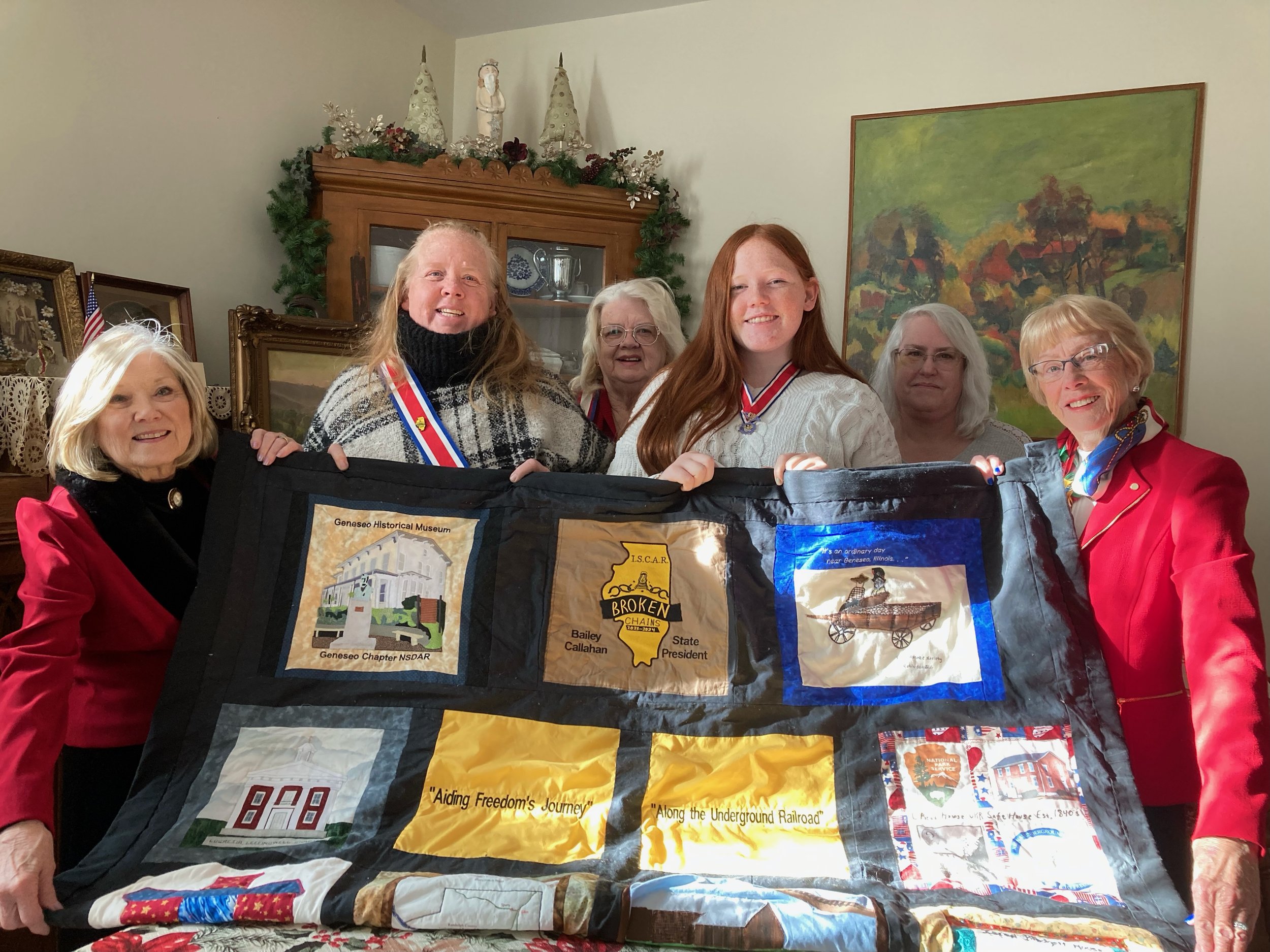By Claudia Loucks
Geneseo Current
A quilt that tells the story of how people helped fugitive slaves on their journey to freedom recently was presented to the Geneseo Historical Museum. In the photo with the quilt are, Angie Snook, left; retired curator/director of the Museum; Amie Callahan, senior national vice president of the Great Lakes Region of the NSCAR; Bailey Callahan, (Amie Callahan’s daughter) former state president of the Illinois Society Children of the American Revolution (NSCAR); Mary Gustafson, Geneseo, Honorary State Regent, Illinois DAR; in back, Luanne Bruckner, past national vice president of the Great Lakes Region (NSCAR); Colleen Woehl; and Amy Balensiefen, Geneseo DAR Chapter Regent. The quilt blocks tell the story of “Aiding Freedom's Journey,” and those explanations are included in the quilt exhibit at the Geneseo Museum. Photo by Claudia Loucks
Angie Snook, left, and Bailey Callahan, are shown with the quilt now on display at the Geneseo Historical Museum. Photo by Claudia Loucks
“The Broken Chains: Aiding Freedom’s Journey” Project was conceived and developed by Bailey Callahan, Moline, at age 13, when she was State President of the Illinois Society Children of the American Revolution (ISCAR), in 2023-2024.
She visited the Geneseo Historical Museum when she was younger and was inspired by the stories she learned about how the people in Geneseo helped fugitive slaves escape along the Underground Railroad.
As State President of ISCAR, she wanted to not only fundraise for signs at the museum, but also inspire members of the Illinois CAR and others to learn about the Underground Railroad in Illinois.
She asked for CAR Societies and DAR Chapters to design and create quilt blocks that reflected how people in their own communities helped those journeying to freedom along the Underground Railroad. The blocks were assembled in March of this year and hand-quilted by Colleen Woehl of Chadwick, IL, before being presented to the Geneseo Historical Museum on Saturday, Dec. 7.
The quilt presentation also was a memorable moment for Angie Snook, who retired in June of this year as curator/director of the Museum, as she had shared so many stories about the slaves and the Underground Railroad and led so many tours to show the hiding hole in the basement of the Museum.
And Bailey Callahan did more than spearhead efforts for the quilt.
Callahan, daughter of Michael and Amie Callahan, and a Moline High School sophomore, was instrumental in fundraising for a sign, now in place on the front of the museum that recognizes the museum as at one time being used to help hide slaves on their journey to freedom north to Canada along the Underground Railroad.
Callahan’s interest in the Underground Railroad began when she first visited the museum with her local CAR Society (Charles Carroll Society), which is under the umbrella of the Illinois Society Children of the American Revolution.
Angie Snook, who then was curator/director of the museum, took the group on a tour of the historic house and shared many stories from the past, including that of the hiding hole located in the basement of the museum.
“We got to see the hiding hole in the basement of the museum and hear the stories,” she said. “I especially remember hearing about the two men who dressed in funeral clothes (women’s 1800’s mourning clothes) and walked past the slave hunters without the slave hunters realizing the ‘women’ were actually the escaped slaves. That visit sparked my interest in learning about the Underground Railroad.”
She read books about Harriet Tubman, Sojourner Truth; and others, “and I took my home school group to the museum in 2019 to show them the hiding hole,” Callahan said.
Callahan shared that her family is very active in the Children of the American Revolution.
“One part is about education and the other is a related fundraiser,” Callahan explained. “For my project, I chose the theme ‘Broken Chains: Aiding Freedom’s Journey’ One of the things my visits to the museum taught me was that the Underground Railroad happened here in Illinois. It wasn’t just a story from a history book. It was real. Slavery was a horrible thing, but people in Illinois took the risk to help people in need. I wanted the members of the Illinois CAR to learn about how people in their own communities helped others along the Underground Railroad.”
THE BLOCKS FROM THE QUILT INCLUDE:
-The block in the upper left corner is a representation of the Geneseo Historical and was sponsored by the Geneseo Chapter NSDAR. The Geneseo Historical Museum was the home of the Richards-Thede family who hid fugitive slaves in a “hidey hole” in their basement. One of the favorite stories about how this family helped fugitive slaves escape is about two freedom seekers who were being searched for by slave hunters who were at a hotel across the street. The family dressed the men as women in mourning clothes, complete with black veils. The fugitives were able to walk safely past their owner and the slave hunters without being recognized.
-The top right block is a representation of another of the favorite stories told about the people of Geneseo and how they helped protect freedom seekers on the Underground Railroad. The block was designed by Scarlett Williamson of Robinson, IL, and the Fort LaMotte Society, CAR. This is how Bailey Callahan retold the story of Helen Cone Richards as she spoke around the State to raise awareness of the project and the Underground Railroad in Illinois.
“It’s an ordinary day in Geneseo, Illinois, in the mid 1800’s. The sun is shining, the birds are singing and you are on the way to the market in Lyndon with a load of potatoes. Seems ordinary, but it’s not. It’s not ordinary because you believe that one person should not own another person. You are so passionate in this belief that you are risking your life and the life of your family to help the people hidden under your potatoes. A couple of men approach you on horseback. You are careful not to show that it is anything but an ordinary day. These men are slave hunters and they are searching wagons for escaped slaves. As they search your wagon they stab the pitchfork down into your potatoes, but they find nothing. After they are satisfied, you continue on your mission, your cargo safe in the hidden compartment.”


